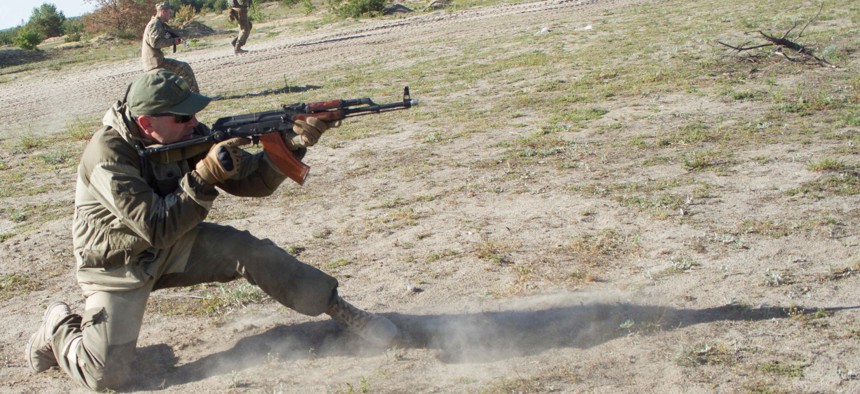
A Ukrainian soldier uses an AK-74, the standard issue rifle for the Ukrainian army, during training in Ukraine on May 22, 2017. U.S. Army / Sgt. Anthony Jones
US Looks to Shift Ukraine from Soviet to NATO Weapons
“It would just be easier if we were using similar systems,” said one expert, as U.S. officials mull long–term efforts to resupply Ukraine’s arsenal.
The latest tranche of U.S. military support for Ukraine sends long-range weapons to defend the Donbas region, and also opens the door to a future when the Ukrainian army fights with the same small arms and artillery as the West.
Since the invasion began, Ukraine has largely defended itself using Soviet-era arms—such as the AK-74, their standard-issue rifle—because Ukrainian forces were familiar with those weapons. Many of Ukraine’s weapons fire different round sizes than U.S. versions and are not compatible.
“It's what they inherited after the end of the Cold War,” said German Marshall Fund fellow Steven Keil. “It makes up a bulk of their own military capacity.”
In recent weeks, as the United States has worked to get weapons to Ukraine, it offered a deal to Eastern European and former Soviet Bloc countries that held stockpiles of Russian-specific munitions: If those countries would send their arms to Ukraine, the U.S. would replace them with NATO-standard guns, artillery, air defenses, and aircraft.
“From NATO’s point of view, this has been a win-win-win,” said Mark Cancian, a senior advisor at the Center for Strategic and International Studies. “It makes the logistics easier. And the supplying of weapons easier because you have a broader sort of set of suppliers.”
It could also accelerate Kyiv’s modernization to NATO-standard weapons, no matter whether Ukraine joins the alliance.
For example, Ukraine and other former Soviet republics inherited the Soviet-designed self-propelled 152 howitzer as heavy artillery. It’s a different gun and uses a different projectile than the U.S.-made 155 howitzer.
With the 152s, “I'm not sure where they can get them. I don't know if anyone produces them,” Cancian said. “Whereas when you're talking 155, there are a half-a-dozen countries that will produce a self-propelled 155. So when it comes time to rebuild the Ukrainian military, that's going to become an issue.”
Monday’s latest announcement of $322 million in foreign military financing—part of a massive $3.4 billion in security assistance from the United States to Ukraine since the war began—supports the continued purchase of Soviet-era munitions, for now. But “as these items become more difficult to procure, FMF could be used to assist with the [Armed Forces of Ukraine] transition to U.S./NATO caliber systems for long-range firing, including multiple launch rocket systems (MLRS) and artillery,” according to a summary of the aid obtained by Defense One.
Furthermore, the money can be used for “modernizing Ukraine's weapons inventory through the provision of more precise and capable weapons, including sniper rifles, rocket-propelled grenade launchers, and other small arms,” said a U.S. official who spoke to Defense One on background. That means those systems could also transition to NATO/U.S.-standard weaponry, if that is what Ukraine chooses.
“Up until now, we've been working at helping them meet their immediate needs,” the U.S. official said. “Now we're getting to the place where we need to start looking ahead to additional future possibilities.”
That has a strategic impact, Keil said.
“Using systems that are newer, newer generation aircraft or, more widely used caliber of artillery, is definitely in NATO's interest,” Keil said. “Particularly in the event of conflict … it would just be easier if we were using similar systems.”
Early in the fighting, the lack of interoperability was one of the reasons the U.S. did not send Patriot missile defense systems to Ukraine. Ukrainian forces would have needed U.S. training and support in Ukraine, which President Joe Biden was unwilling to do.
Each of the more advanced systems now under consideration would also require training—not only on how to operate them, but also on how to maintain them. The U.S. official said the extent of the longer-term support is still being worked through.
“We’re not there yet. We're just taking the initial first step,” the official said.
But the groundwork is already being laid. Earlier this month, Deputy Defense Secretary Kathleen Hicks met with the CEOs of America’s largest defense companies to look for ways to speed up weapons deliveries to Ukraine. Global defense stocks have largely risen in the weeks following Russia’s invasion, especially after NATO allies increased plans to boost military spending.
But last week, Lockheed Martin CEO Jim Taiclet refused to speculate about how the conflict might affect weapon sales for the world’s largest defense contractor.
“The environment is more challenging from a national security and global security perspective than it was before,” Taiclet told investment analysts on the company’s quarterly earnings call. “That suggests that deterrence is a more valuable product than it's ever been, at least in the last 80 to 100 years. We feel we're really positioned well with our strategy to meet that need for national security and global security. But we can't quantify yet exactly how that's going to touch our revenue…until we get actual contracts that have order schedules.”
Marcus Weisgerber contributed to this report.
NEXT STORY: How Much Can US Howitzers Help Ukraine?




